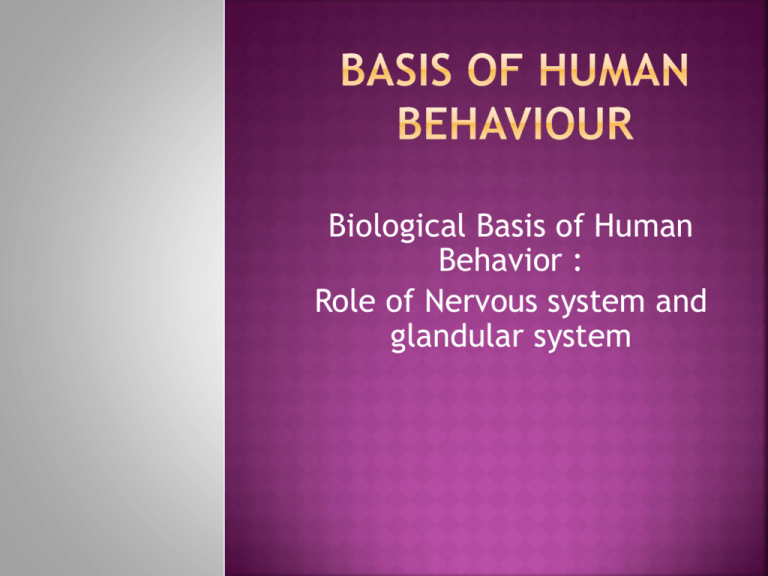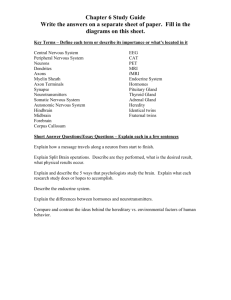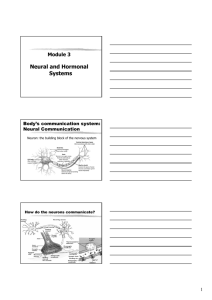To - Master In Social Work
advertisement

Biological Basis of Human Behavior : Role of Nervous system and glandular system The capacity of mental, physical, emotional, and social activities experienced during the five stages of a human being's life - prenatal, infancy,childhood,adolescence,and adulthood. Includes the behaviours as dictated by culture, society,values,morals,ethical, and genetics. The part of human’s body that coordinates its voluntary and involuntary actions and transmits signals between different parts of the body. The nervous system is a complex collection of nerves and specialized cells known as neurons The nerves send messages for controlling movement and feeling between the brain and the other parts of the body. CONT....... .. Nervous System Central Nervous System made up of brain and spinal cord. Peripheral Nervous System made up of the nerve fibres that branch off from the spinal cord and extend to all parts of the body The brain sends messages through the spinal cord and nerves of the peripheral nervous system to control the movement of the muscles and the function of internal organs. The basic working unit of the nervous system is a cell called a neuron. The human brain contains about 100 billion neurons. A neuron consists of a cell body containing the nucleus, and special extensions called axons and dendrites. Neurons communicate with each other using axons and dendrites. When a neuron receives a message from another neuron, it sends an electrical signal down the length of its axon. At the end of the axon, the electrical signal is converted into a chemical signal, and the axon releases chemical messengers called neurotransmitters. The neurotransmitters are released into the space between the end of an axon and the tip of a dendrite from another neuron. This space is called a synapse. The neurotransmitters travel the short distance through the synapse to the dendrite. The dendrite receives the neurotransmitters and converts them back into an electrical signal. The signal then travels through the neuron, to be converted back into a chemical signal when it gets to neighbouring neurons. The brain is made up of many networks of these communicating neurons. In this way, different parts of the brain can “talk” to each other as well as work together to send messages to the rest of the body. The most complicated and mysterious systems in the human body. Lots of emotional and physical issues get blamed--rightly or wrongly on hormones. There is no doubt that this complicated system can get out of balance especially when it is not taken care of with good nutrition and lifestyle habit. Exocrine glands [exo-, outside + crin, secrete] secrete substances through a duct or tube, usually to an outside surface. Examples are tear glands, salivary glands, and sweat glands. Endocrine glands [endo-, within + crin, secrete] are "ductless glands" which secrete substances directly into the blood stream, which carries it to target tissues or organs where it stimulates some type of action. The substances secreted by endocrine glands are called hormones, from the Greek word meaning "to urge on" or "to set in motion." Examples of endocrine glands are the pineal, pituitary, thyroid, parathyroid, thymus, pancreas, adrenals and the sex glands (the ovaries and testes). The nervous system and glandular system are similar in that they are "communication systems." The nervous system uses electrical impulses and chemicals called neurotransmitters to relay fast, short lived messages. The glandular system uses hormones generally secreted directly into the bloodstream to communicate. With both the nervous and glandular systems, the signals created by these communications (of hormones and electrical impulses) must be received by receptor cells. The receptor cells receive the signal and initiate the affected part of the body to respond to that signal, similar to how a speaker of a radio moving in response to the electrical signals sent to it. The glandular system works, along with the nervous system, to maintain balance among all the body systems. Together, these systems regulate voluntary and involuntary actions within the body, such as growth, metabolism, digestion, elimination, menstruation, and sleep. These two systems are the means of communication between cells. In general, the glands that secrete chemicals directly into the bloodstream are called endocrine glands, and form the endocrine system. Other glands--such as tear glands, saliva glands, and sweat glands--are ductless glands that secrete their chemicals outside the bloodstream, and form the exocrine system Society for Neuroscience. (2012). What is Neuroscience? Retrieved July 31, 2012, from http://www.sfn.org/index.aspx?pagename=whatIsN euroscience Society for Neuroscience. (2012). What is Neuroscience? Retrieved August 2, 2012, from http://www.brainfacts.org/aboutneuroscience/what-is-neuroscience









